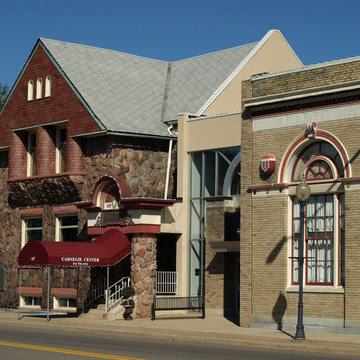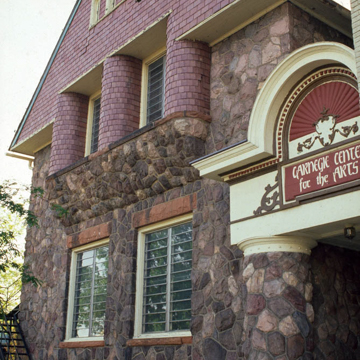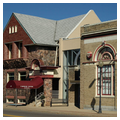You are here
Carnegie Center for the Arts (Three Rivers Public Library) and W. R. Monroe Museum
On a triangular block bounded by Portage, N. Main, and Prutzman streets is the trapezoidal former Three Rivers Public Library designed by Rush and Sons of Grand Rapids and Kalamazoo. The footprint of the building conforms to a site shaped by the diagonal section of the grid pattern of the city's streets made by Portage Street as it follows the path of the Portage River. The Portage River and the St. Joseph and Rocky rivers converge at Three Rivers, dividing the city into several distinct districts. This two-story Shingle Style library was built alongside commercial buildings in the business district.
The exterior walls of both the N. Front Street front facade and the Portage Street rear facade are laid with broken pink granite fieldstones; the side walls are brick. The front windows are trimmed with red Lake Superior sandstone. Lilac-colored slate clads the walls of the front gable and curves into the recessed paired windows of the second story. Piers support the ample entablature and full-arch crown of the distinctive recessed entrance portal. From the foyer a long hall leads into the heart of the building—the book delivery and reading room on the first floor. A wooden spindlework staircase rises to the second floor's assembly room with a stage and a director's room. Light filtered through a stained glass skylight illuminates a second-floor rotunda and the book delivery room below. In the book delivery room, marbleized Doric columns support broad archways and a fireplace is on the north wall.
The Carnegie Foundation funded the library's construction; Warren J. Willets (1853–1904), a local banker who was the former president of the Sheffield Car Company, donated the lot. Unlike most Carnegie libraries in the Beaux-Arts classical style, the Three Rivers library is reminiscent of H. H. Richardson's late domestic work. Today the Three Rivers Public Library is reused as the Carnegie Center for the Arts. Its interior is intact. The center is linked to the W. R. Monroe Museum that opened in 1997.
Writing Credits
If SAH Archipedia has been useful to you, please consider supporting it.
SAH Archipedia tells the story of the United States through its buildings, landscapes, and cities. This freely available resource empowers the public with authoritative knowledge that deepens their understanding and appreciation of the built environment. But the Society of Architectural Historians, which created SAH Archipedia with University of Virginia Press, needs your support to maintain the high-caliber research, writing, photography, cartography, editing, design, and programming that make SAH Archipedia a trusted online resource available to all who value the history of place, heritage tourism, and learning.





